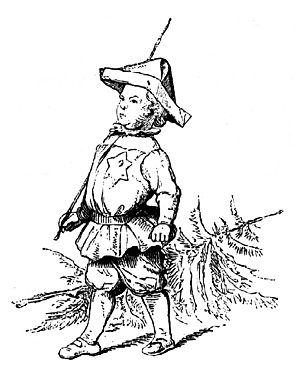The Fir-Tree facts for kids
Quick facts for kids "The Fir-Tree" |
|
|---|---|
| Author | Hans Christian Andersen |
| Original title | "Grantræet" |
| Country | Denmark |
| Language | Danish |
| Genre(s) | Literary fairy tale |
| Published in | New Fairy Tales. First Volume. Second Collection (Nye Eventyr. Første Bind. Anden Samling) |
| Publication type | Fairy tale collection |
| Publisher | C.A. Reitzel |
| Media type | |
| Publication date | 21 December 1844 |
| Followed by | "The Snow Queen: A Fairy Tale in Seven Stories" |
"The Fir-Tree" (Danish: Grantræet) is a literary fairy tale by the Danish poet and author Hans Christian Andersen (1805–1875). The tale is about a fir tree so anxious to grow up, so anxious for greater things, that he cannot appreciate living in the moment. The tale was first published 21 December 1844 with "The Snow Queen", in New Fairy Tales. First Volume. Second Collection, in Copenhagen, Denmark, by C.A. Reitzel. One scholar (Andersen biographer Jackie Wullschlager) indicates that "The Fir-Tree" was the first of Andersen's fairy tales to express a deep pessimism.
Plot summary
In the woods stands a little fir-tree. He is preoccupied with growing up and is thoroughly embarrassed when a hare hops over him, an act which emphasizes his diminutiveness. The women call him the baby of the forest and again he is embarrassed and frustrated. A stork tells him of seeing older trees chopped down and used as ship masts, and the little tree envies them. In the fall, nearby trees are felled and the sparrows tell the little fir-tree of seeing them decorated in houses.
One day while still in his youth, the fir-tree is cut down for a Christmas decoration. He is bought, carried into a house, decorated, and, on Christmas Eve, glows with candles, colored apples, toys, and baskets of candy. A gold star tops the tree. The children enter and plunder the tree of its candy and gifts, then listen to a little fat man tell the story of 'Klumpe-Dumpe' "who fell down-stairs, and yet was raised to high honours, and obtained the princess's hand". (Most English translations render 'Klumpe-Dumpe' as "Humpty Dumpty", which sounds similar, although Mette Norgaard points out that the story is different, of the "Blockhead Hans" type.)
The next day, the fir-tree expects the festivities to be renewed, but servants take the tree down and carry him into the attic. The tree is lonely and disappointed, but the mice gather to hear the tree recite the tale of "Klumpe-Dumpe". Rats arrive and, when they belittle the simple tale, the mice leave and do not return. In the spring, the fir-tree – now withered and discolored – is carried into the yard. A boy walks on the tree and takes the star from its topmost branch. The fir-tree is then cut into pieces and burned.
Adaptations
The tale was adapted to a 28-minute video format in 1979 by Huntingwood Films produced by Kevin Sullivan, directed by Martin Hunter and filmed at Black Creek Pioneer Village, Toronto, Ontario, Canada. Jeff Kahnert provided the voice of the Fir-Tree. This was the first film produced by Kevin Sullivan who went on to write, direct and produce the Anne of Green Gables movies.
It was adapted as the sixteenth episode of The Fairytaler.
In 2011, the story was again adapted as a short, Danish-language film directed by Lars Henrik Ostenfeld and presented in a modern setting. The story follows the tree from cone through seedling, until it is cut down by a boy and his father to be used as a Christmas tree. Unlike Andersen's tale, which ends with the burning of the tree, the film shows a cone from the tree surviving the fire and being thrown into the forest, perhaps to grow into another fir tree.
In 2014, Janani Sreenivasan adapted her script "Pine", originally performed at the University of Iowa's No Shame Theatre in December 2006, into the short film "The Fir Tree", which she co-directed with Lee Jutton. In this version, we hear the tree's first-person account (in Danish) of being chopped down and attending its first Christmas party, which ends badly for all involved.
See also
 In Spanish: El abeto para niños
In Spanish: El abeto para niños


